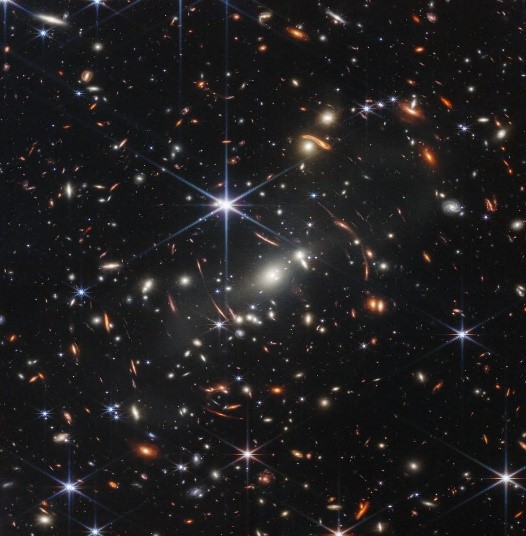Published on: July 15, 2022

JAMES WEBB TELESCOPE
JAMES WEBB TELESCOPE

Why in news?
The first image from NASA’s new space telescope unveiled is brimming with galaxies and offers the deepest look of the cosmos ever captured.
Highlights:
- The first image from the $10 billion James Webb Space Telescope is the farthest humanity has ever seen in both time and distance, closer to the dawn of time and the edge of the universe. That image will be followed by the release of four more galactic beauty shots from the telescope’s initial outward gazes.
About the image:
- The “deep field” image released is filled with lots of stars, with massive galaxies in the foreground and faint and extremely distant galaxies peeking through here and there. Part of the image is light from not too long after the Big Bang, which was 13.8 billion years ago.
- The images on tap include a view of a giant gaseous planet outside our solar system, two images of a nebula where stars are born and die in spectacular beauty and an update of a classic image of five tightly clustered galaxies that dance around each other.
Exploring the cosmos
- The telescope also found water vapour in the atmosphere of a faraway gas planet. The spectroscopy – an analysis of light that reveals detailed information – was of planet WASP-96 b, which was discovered in 2014.
- Nearly 1,150 light-years from Earth, WASP-96 b is about half the mass of Jupiter and zips around its star in just 3.4 days.
The James Webb Space Telescope
- The world’s biggest and most powerful space telescope rocketed away last December from French Guiana in South America on an Ariane 5 rocket, Webb is orbiting the Sun at a distance of a million miles (1.6 million kilometers) from Earth, in a region of space called the second Lagrange point.
- It reached its lookout point 1 million miles (1.6 million kilometers) from Earth in January. Then the lengthy process began to align the mirrors, get the infrared detectors cold enough to operate and calibrate the science instruments, all protected by a sunshade the size of a tennis court that keeps the telescope cool.
- The plan is to use the telescope to peer back so far that scientists will get a glimpse of the early days of the universe about 13.7 billion years ago and zoom in on closer cosmic objects, even our own solar system, with sharper focus.
- At 21 feet (6.4 meters), Webb’s gold-plated, flower-shaped mirror is the biggest and most sensitive ever sent into space. It’s comprised of 18 segments, one of which was smacked by a bigger than anticipated micrometeoroid in May. Four previous micrometeoroid strikes to the mirror were smaller. Despite the impacts, the telescope has continued to exceed mission requirements, with barely any data loss, according to NASA.
- NASA is collaborating on Webb with the European and Canadian space agencies.
Successor to the Hubble Space Telescope
- Webb is considered the successor to the highly successful, but aging Hubble Space Telescope. Hubble has stared as far back as 13.4 billion years. It found the light wave signature of an extremely bright galaxy in 2016. Astronomers measure how far back they look in light-years with one light-year being 5.8 trillion miles (9.3 trillion kilometers).
Why are telescopes in space?
- The thermal turbulence of the Earth’s atmosphere hinders telescopic observation of the universe. Stars twinkle, light from the faint stellar objects are absorbed by the thick lower atmosphere, and part of the spectrum, such as infrared rays from space, hardly reach the ground. By placing the telescopes on a high mountain top, we avoid as much atmosphere as possible. Yet the atmospheric turbulence hinders the super-sharp images of objects in space.
-
Telescopes in space altogether avoid the atmospheric disturbance and provide us with a clear, sharp and more profound vision of the farthest reaches of the universe. While the most giant ground-based telescopes revealed galaxies over 5 billion light-years away, the Hubble space telescope has identified the farthest known galaxy located at whooping 13.4 billion years in the past.

